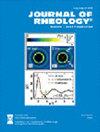从溶液流变学测定超高分子量聚乙烯的分子量分布
IF 3.2
2区 工程技术
Q2 MECHANICS
引用次数: 3
摘要
我们研究了超高分子量聚乙烯(UHMWPE)溶液的线性流变学,目的是确定聚合物的分子量分布。将UHMWPE溶解在低聚乙烯中,以避免与溶剂的不利相互作用有关的问题。为了制备溶液,UHMWPE、溶剂和固定量的抗氧化剂通过共旋双螺杆微混合器混合。所有制备的溶液都在浓缩状态下,主要流变参数(平台模量、弛豫时间和零剪切粘度)随浓度的比例定律证实了这一点。基于解的粘弹性响应,我们根据时间-浓度叠加原理,采用启发式方法来推断熔体的线性粘弹性行为。这种技术使我们能够跨越几十年的角频率,最终达到最终弛豫状态。后者很难在熔融状态下通过直接测量来实现,这是因为实验问题,例如超长的实验时间和热极限。熔体的粘弹性光谱用于根据含时扩散/双报告模型获得分子量分布(MWD)。使用该方法评估的UHMWPE的MWD与凝胶渗透色谱法获得的数据一致。本文章由计算机程序翻译,如有差异,请以英文原文为准。
Determination of the molecular weight distribution of ultrahigh molecular weight polyethylene from solution rheology
We investigate the linear rheology of ultrahigh molecular weight polyethylene (UHMWPE) solutions with the aim of determining the molecular weight distribution of the polymer. The UHMWPE is dissolved in oligo-ethylene in order to avoid issues related to unfavorable interactions with the solvent. To prepare the solutions, UHMWPE, solvent, and a fixed amount of antioxidants are mixed by means of a corotating twin-screw microcompounder. All prepared solutions are within the concentrated regime, as confirmed by the scaling laws of the main rheological parameters (plateau modulus, relaxation time, and zero-shear viscosity) with concentration. Based on the viscoelastic response of the solutions, we adopt a heuristic approach to extrapolate the linear viscoelastic behavior of the melt, according to a time-concentration superposition principle. Such a technique allows us to span many decades of angular frequency, eventually attaining the terminal relaxation regime. The latter is difficult to achieve by direct measurements in the molten state because of experimental issues such as extremely long experimental times and thermal limits. The viscoelastic spectrum of the melt is used to obtain the molecular weight distribution (MWD) according to the time-dependent diffusion/double reptation model. The MWD of UHMWPE evaluated by using this approach agrees well with data obtained from gel permeation chromatography.
求助全文
通过发布文献求助,成功后即可免费获取论文全文。
去求助
来源期刊

Journal of Rheology
物理-力学
CiteScore
6.60
自引率
12.10%
发文量
100
审稿时长
1 months
期刊介绍:
The Journal of Rheology, formerly the Transactions of The Society of Rheology, is published six times per year by The Society of Rheology, a member society of the American Institute of Physics, through AIP Publishing. It provides in-depth interdisciplinary coverage of theoretical and experimental issues drawn from industry and academia. The Journal of Rheology is published for professionals and students in chemistry, physics, engineering, material science, and mathematics.
 求助内容:
求助内容: 应助结果提醒方式:
应助结果提醒方式:


